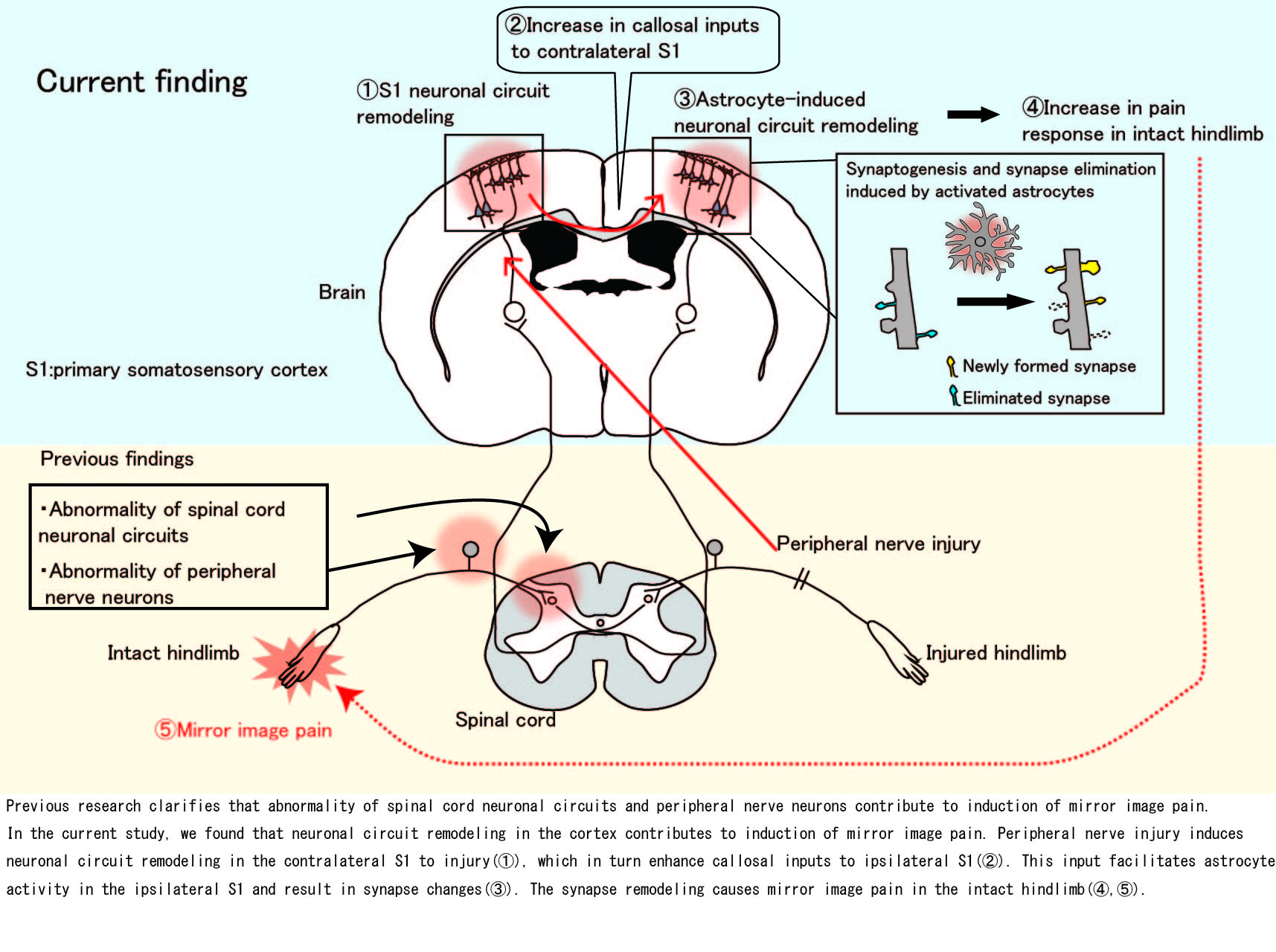Cortical astrocytes prime the induction of spine plasticity and mirror image pain.
Pain is the important information to avoid danger from our body. On the other hand, long-lasting pain without any danger is called as chronic pain. Peripheral nerve injury induces plastic changes in the central nervous system, which in turn causes chronic pain. In addition to the injured limb, long-lasting pain can appear in the contralateral (intact) limb to injury, which is called mirror image pain. However, the mechanisms of mirror image pain are less known. Recent our research suggests that in the primary somatosensory cortex (S1), which has roles in recognition of location and intensity of pain, peripheral nerve injury induces activation of astrocytes and these cells cause the synaptic remodeling, and this remodeling induces chronic pain. Thus, we hypothesized that astrocytes in the ipsilateral S1 to nerve injury might be involved in induction and maintenance of mirror image pain. To elucidate this issue, we conducted in vivo calcium imaging of neurons and astrocytes in the S1 ipsilateral to the peripheral nerve injury.
We found that after nerve injury, activities of inhibitory neurons and astrocytes increased and blockade of contralateral S1 to nerve injury reduced activities of both types of cells. Intact hindpaw contralateral to injury did not show any abnormal behavior after peripheral nerve injury. On the other hand, chronic blockade of inhibitory neuronal functions in the ipsilateral S1 to injured hindpaw induced remarkable changes of dendritic spines, and caused the mirror image pain in the intact hindpaw. In addition to these results, blockade of astrocytic hyperactivity inhibited the synaptic changes in the ipsilateral S1 and did not induce the mirror image pain to the intact hindpaw. Thus, these results suggest that activation of astrocytes in the ipsilateral S1 to peripheral nerve injury contributes to induction of synaptic remodeling, which in turn causes mirror image pain in the intact hindpaw.
This research sheds light on the mechanisms of the mirror image pain and provides a new efficient therapeutic strategy against not only mirror image pain but also chronic pain by focusing on astrocytes in the S1.

Collaborative Researchers
Name: Sun Kwang Kim
Department: Kyung Hee University College of Korean Medicine
Institute: Department of Physiology
Name: Hiroaki Wake
Department: Kobe University Graduate School of Medicine
Institute: Division of System Neuroscience
Name: Andrew J Moorhouse
Department: School of Medical Sciences, The University of New South
Institute: Membrane and Cellular Biophysics
Name: Hitoshi Ishibashi
Department: Kitasato University School of Allied Health Sciences
Institute: Department of Physiology
Funding
Core Research for Evolutional Science and Technology (CREST) grant from the Japan Agency for Medical Research and Development (AMED)
Grant-in-Aids for Scientific Research (A) (22240042 to J. Nabekura),
Grant-in-Aid for Young Scientists (15K21604 to T. Ishikawa)
Grant-in-Aid for Young Scientists (15K21603 to K. Eto),
Grant-in-Aids for Scientific Research (C) (17K09051 to K. Eto),
Grant-in-Aid for Scientific Research on Innovative Areas-Resource and technical support platforms for promoting research 'Advanced Bioimaging Support (JP16H06280).

